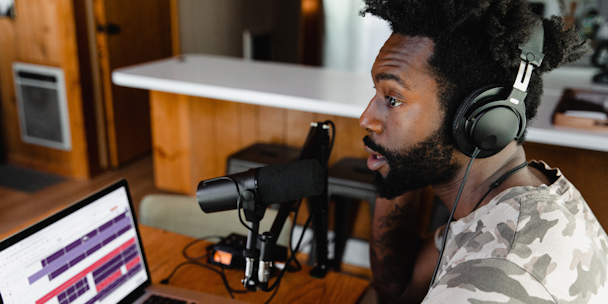It's all about audio: how to make the most of podcasting and social audio
With major announcements this week from both Apple and Facebook, it seems both podcasting and social audio are a keen focus for world’s biggest tech players.

Wilderness on how marketers can make better use of audio and why now is the time to do so / Unsplash
Podcasting 2.0
With the announcement last week from Apple that they are introducing a paid subscription model for podcasting and a long-overdue revamp of their podcasting app, it seems the company is finally taking podcasting seriously – 15 years after bringing the medium to the mainstream.
The move comes after industry reporting suggested that for the first time Spotify would be the dominant podcasting platform. Spotify have been investing heavily in podcasting, noting earlier this year that they had tripled the number of podcasts on their platform and signed a number of exclusive high-profile deals with the likes of Joe Rogan, Kim Kardashian and Michelle Obama.
Spotify have in fact already announced their plan to launch a podcasting subscription service, but it seems Apple have got there first. This can only be good news for podcast creators, giving them more opportunities to monetize their content and new ways for fans to engage and support their favourite podcasters and shows.
With a move away from an ad-funded model, the future for brands in podcasting is to create their own unique content or create long-term lasting partnerships with creators and publishers. The challenge for brands is to overcome the inherent belief from listeners that they are in it for the promotion and instead create opportunities for meaningful and diverse conversations and stories.
The rise of social audio
This is probably not the first piece you have read in the last few months, or even the last few weeks or days, about social audio. The buzz around the emergence of this new style of social communication is huge. Facebook this week announced a slew of upcoming bets in audio, including an expanded partnership with Spotify and its very own Clubhouse clone.
Clubhouse is the current darling of the social scene, but imitations are quickly catching up, with Facebook set to roll out their clone in the next six months and Twitter rolling out their own version, Spaces, to its global user base at the end of the month following a successful beta test.
Social audio has the potential to create the same sense of intimacy an audience has with a podcast or audiobook, but with the huge added elements of social functionality and being part of a wider community.
My prediction for how this plays out is that the real winner here will actually be Twitter. Why? Well, they seem to have taken a play from Facebook’s well worn track of cloning the competition and using the significant power of their existing user base and social graph to topple an upstart competitor (sounds familiar, right?)
The second-mover advantage here can not be underestimated. In moving fast to create Spaces, and learning from what has worked on Clubhouse, Twitter can now play to two key strengths over its upstart competitor.
Firstly, no platform can boast greater influence from the world’s leading journalists, celebrities, politicians, academics and sports stars than Twitter – ensuring that Spaces instantly has some of the deepest thinkers creating conversations from day one.
Secondly, it has close to 200 million active users, many of whom have been crying out for the platform to innovate (still waiting on that edit button), while it is reported Clubhouse has close to 10 million users. Growth in the last few months has slowed and it is yet to launch its Android app, opening to the platform to millions more users.
This type of audio communication feels much more native to a platform like Twitter than Facebook or Instagram, but Facebook does have a trump card as WhatsApp presents interesting audio opportunities. But that is for another post.
I think Twitter will continue to innovate in this space and, unlike Facebook, see audio as a big part of the future of how we all communicate and share ideas – rather than just another feature set.
Tom Jarvis is founder and CEO at Wilderness.
Content by The Drum Network member:

Wilderness
The World's First Social Media Transformation Agency. We transform the strategy, management, and operations of the world’s most beloved brands. Part of the...
Find out more
